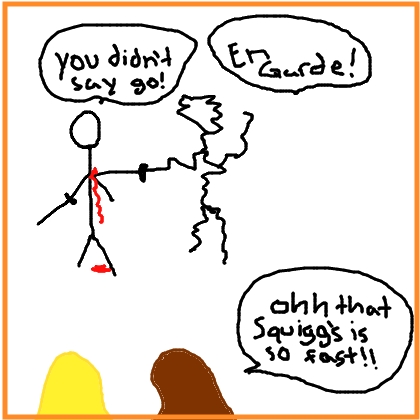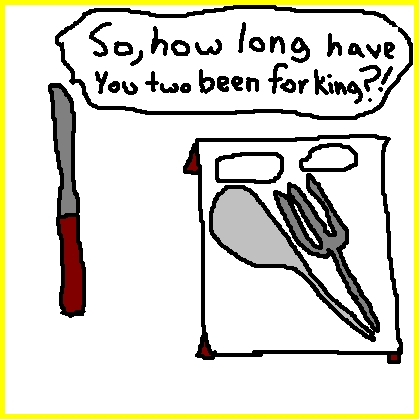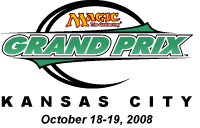The day after you read this, I’ll be a day away from Kansas City, Missouri. That means that a day after that I’ll be playing in Day 1 of the GP, and day and a half after that I’ll be doing Goldschlogger body shots out of my first-place trophy off Evan Erwin milky-white bare chest. That’s of course pending that Mr. Magic Show and I will be getting drunk on Sunday night, and also pending that I win the GP. I must say, I always have a way of jinxing myself, so don’t be surprised to see me on the sidelines on three days from now, faded out of my mind.
Whenever new Sealed formats come around, I always feel that people try too hard to find out what’s going on in the format. Personally, I find the best way is to buy a box of tournament packs and a box of boosters and spend a few hours building them all. Usually it helps to have someone with you when you’re building, to make sure your instincts are on par, but I couldn’t find anyone good enough that would expedite the process near me, and lord knows I’m not tapping into Billy anytime soon for Limited advice. The Kithkin Rabble incident is still too fresh.
At first glance, this format may seem convoluted and intricate, but it’s actually quite the opposite. There are still only five “colors” available – Naya, Bant, Jund, Esper, and Grixis – and each pool will likely stick to these bases with the obvious potential of splashing other shards if the mana fixing deems it appropriate.
All of the Sealed pools I’ve tackled so far (upwards of thirty) have been extremely easy to read and build. By reading the pool, I look for the three keys.
Creatures
I don’t like going to battle with too few creatures, since there are so many wins you can accumulate by simply having more creatures than your opponent in Limited formats. This, of course, means quality creatures, leaving those Godtouchers and Viashino Skeletons on the bench.
Removal
This is another incentive to dig into any given color. If there is a plethora of removal spells, it doesn’t really matter what your creature base looks like. You can play any number of two mana 2/2s and not be too worse off, since you will be able to remove those pesky bigger dudes that clog the board up a lot of the time.
Stability
Stability refers to both your curve and manabase. If you have a steady stream of creatures focusing on mana costs 2-4 with a few powerful late game dudes, you’re in good shape to have the option to cast all your spells, which makes it much easier to outplay your opponent. The mana is equally important, since you can’t realistically cast all your spells if you don’t have the fixing to support it (or enough sources of each mana type in your deck). Since I’m preparing for a long multi-round tournament, finding out how to make the mana work is the most important factor in having consistent games.
Practice leads to consistency, consistency leads to success, success leads to body shots off Evan Erwin chest. It’s a fragile process that I don’t intend to break.
Honestly, reading your pool is extremely important, since it will tell you the colors to play if you can translate the trends and learn to evaluate them. For most, it’s a pretty intuitive process of taking the above three keys and shifting your focus on them between the different colors that you’re examining, eventually happening upon a build that almost pieces itself together.
Creatures (40)
- 1 Hell's Thunder
- 1 Akrasan Squire
- 1 Bant Battlemage
- 1 Battlegrace Angel
- 1 Gustrider Exuberant
- 2 Welkin Guide
- 2 Jhessian Lookout
- 2 Outrider of Jhess
- 1 Sphinx's Herald
- 1 Vectis Silencers
- 1 Blister Beetle
- 2 Dreg Reaver
- 1 Dregscape Zombie
- 1 Grixis Battlemage
- 1 Shore Snapper
- 1 Viscera Dragger
- 1 Bloodpyre Elemental
- 1 Bloodthorn Taunter
- 1 Viashino Skeleton
- 2 Vithian Stinger
- 1 Court Archers
- 1 Cylian Elf
- 1 Drumhunter
- 1 Elvish Visionary
- 1 Godtoucher
- 2 Wild Nacatl
- 1 Deft Duelist
- 1 Rakeclaw Gargantuan
- 2 Rip-Clan Crasher
- 1 Sprouting Thrinax
- 1 Steward of Valeron
- 1 Thoughtcutter Agent
- 1 Tower Gargoyle
Lands (4)
Spells (29)
- 1 Naturalize
- 1 Cancel
- 1 Angelic Benediction
- 1 Angelsong
- 1 Marble Chalice
- 1 Resounding Silence
- 1 Soul's Grace
- 1 Covenant of Minds
- 1 Etherium Astrolabe
- 1 Memory Erosion
- 1 Resounding Wave
- 1 Bone Splinters
- 2 Executioner's Capsule
- 1 Onyx Goblet
- 1 Resounding Scream
- 1 Dragon Fodder
- 1 Resounding Thunder
- 1 Soul's Fire
- 1 Lush Growth
- 1 Resounding Roar
- 1 Agony Warp
- 1 Grixis Charm
- 1 Hindering Light
- 1 Kiss of the Amesha
- 1 Sangrite Surge
- 1 Violent Ultimatum
- 1 Obelisk of Esper
- 1 Relic of Progenitus

This pool represents a clear case of following the removal. In Shards Sealed, it’s actually much easier than in the past to define your colors. All you have to do is find the two weakest and cut them… then you’ll hopefully be left with a Shard. In this situation, Blue and White are easily axed, leaving us with a solid-looking Jund base.
2 Wild Nacatl
2 Rip-Clan Crasher
Cylian Elf
Dregscape Zombie
Blister Beetle
Elvish Visionary
Dragon Fodder
Sprouting Thrinax
Court Archers
2 Vithian Stinger
Hell’s Thunder
Viscera Dragger
Bloodpyre Elemental
2 Executioner’s Capsule
Bone Splinters
Resounding Roar
Resounding Thunder
Soul’s Fire
Violent Ultimatum
A solid 23; however, our lands point to splashing with Jungle Shrine, Arcane Sanctum, and Naya Panorama, so including a Plains would be almost painless. So let’s look at the potential splashes.
Battlegrace Angel
Resounding Silence
2 Welkin Guide
Rakeclaw Gargantuan
Angelsong
These are all “doable” splashes… however, I don’t think four sources is enough to support the Angel safely. I’d like to have five, and that’d be almost suicide with the Jund base and early mana requirements. To find the right splash, we have to analyze what the deck that’s been laid out for us actually does.
It has a huge two-drop slot, as well as the Nacatls in the one-slot, indicating an aggressive curve. This deck has a way of making the two-drops much more effective in the later stages of the game as well, by giving them potential to trade up with the pair of Stingers and Blister Beetle, while also being effective fodder for Bone Splinters. That said, the two-drop slot needs to be toned down a bit. Dragon Fodder and Cylian Elf are the worst in the slot, and Violent Ultimatum isn’t getting cast very often in this deck. That makes room for three essentially free splash cards. Of the above group, the Welkin Guides fit in the best with our strategy, while also giving us a deeper curve. From there it’s up in the air between Resounding Silence and Rakeclaw Gargantuan, but I leaned toward the Silence since the five-drop slot would be a bit cluttered with four creatures there. I ended up here:
2 Wild Nacatl
2 Rip-Clan Crasher
Elvish Visionary
Dregscape Zombie
Blister Beetle
Sprouting Thrinax
Court Archers
2 Vithian Stinger
Hell’s Thunder
Viscera Dragger
Bloodpyre Elemental
2 Welkin Guide
2 Executioner’s Capsule
Bone Splinters
Resounding Roar
Resounding Thunder
Soul’s Fire
Resounding Silence
1 Savage Lands
1 Arcane Sanctum
1 Jungle Shrine
1 Naya Panorama
1 Plains
4 Mountain
4 Swamp
4 Forest
The mana works out as having seven sources of each of the Jund colors and four sources of White, giving us a 7-7-7-4 ratio. It’s hard to break from that since I don’t exactly want to go down to six of any of my primary sources, and four sources of White is perfect. I could put an emphasis on getting turn 2 Rip-Clan Crasher by cutting a Swamp for a Mountain, but at the same time I’d like to cast Executioner’s Capsule and kill a creature in the same turn, so I’m somewhat at odds. Thinking it out, cutting a Swamp for a Mountain is probably the right call, since it enhances the likelihood of Nacatl being a 2/2 on turn 2.
I’d be very happy to get this deck at the Grand Prix, as it covers all three keys of success in Sealed. It’s got a lot of creatures (16), plenty of removal/tricks (11), and a very solid manabase which includes a potent splash that provides an end game plan with the pair of Welkin Guide.
Creatures (39)
- 2 Akrasan Squire
- 1 Guardians of Akrasa
- 1 Gustrider Exuberant
- 1 Knight of the Skyward Eye
- 1 Knight-Captain of Eos
- 1 Metallurgeon
- 1 Rockcaster Platoon
- 1 Sigiled Paladin
- 2 Etherium Sculptor
- 1 Vectis Silencers
- 1 Blister Beetle
- 1 Deathgreeter
- 1 Dreg Reaver
- 1 Glaze Fiend
- 1 Puppet Conjurer
- 1 Shore Snapper
- 1 Skeletal Kathari
- 1 Undead Leotau
- 1 Bloodthorn Taunter
- 1 Hissing Iguanar
- 1 Jund Battlemage
- 1 Predator Dragon
- 1 Thunder-Thrash Elder
- 1 Behemoth's Herald
- 1 Cavern Thoctar
- 1 Godtoucher
- 1 Jungle Weaver
- 1 Wild Nacatl
- 1 Bull Cerodon
- 2 Fire-Field Ogre
- 1 Goblin Deathraiders
- 1 Kederekt Creeper
- 1 Rakeclaw Gargantuan
- 1 Sprouting Thrinax
- 1 Waveskimmer Aven
- 1 Woolly Thoctar
Lands (5)
Spells (28)
- 2 Naturalize
- 1 Cancel
- 1 Oblivion Ring
- 1 Angelic Benediction
- 1 Angelsong
- 1 Excommunicate
- 1 Invincible Hymn
- 1 Resounding Silence
- 1 Coma Veil
- 2 Resounding Wave
- 1 Banewasp Affliction
- 1 Immortal Coil
- 1 Resounding Scream
- 1 Shadowfeed
- 2 Dragon Fodder
- 1 Magma Spray
- 1 Soul's Fire
- 1 Lush Growth
- 1 Resounding Roar
- 1 Soul's Might
- 1 Blightning
- 1 Brilliant Ultimatum
- 1 Hindering Light
- 1 Sangrite Surge
- 1 Obelisk of Grixis

Despite the evident presence of Black in the pool, very few Black cards are playable, and Blue is equally uninspiring, with too little to work with. That leaves us with barely enough cards to scrounge together a Naya deck to utilize the power multicolor spells of Woolly Thoctar, Bull Cerodon, and Predator Dragon.
2 Akrasan Squire
Wild Nacatl
Sigiled Paladin
Knight of the Skyward Eye
Guardians of Akrasa
Hissing Iguanar
Thunder-Thrash Elder
Jund Battlemage
Woolly Thoctar
Rakeclaw Gargantuan
Knight-Captain of Eos
Bull Cerodon
Predator Dragon
Jungle Weaver
Magma Spray
Resounding Roar
2 Dragon Fodder
Oblivion Ring
Excommunicate
Soul’s Fire
Resounding Silence
Naya Panorama
Bant Panorama
7 Mountain
4 Forest
5 Plains
There really wasn’t much to work with in this pool, or too many avenues to explore in terms of color combinations. The only playables on the sidelines are Cavern Thoctar, Metallurgeon, Angelsong, and Rockcaster Platoon, but none really fit too well with the curve, or add much more value to the deck that an eighteenth land would.
This brew is fairly aggressive, with an lean early curve filled with small attackers, but it also has some premium drops that will continue to hit hard the whole game. The three-drop slot contains a pair of monstrously large dudes, with Woolly Thoctar and Thunder-Thrash Elder. Guardians of Akrasa and Jund Battlemage hold the fort. Hissing Iguanar is a particularly strong card in decks that feature a high amount of removal, but this looks to abuse him by making Dragon Fodder tokens mini missiles to put some more damage on the table. The late drops are inspiring, with Bull Cerodon and Predator Dragon leading the end-game charge, while a modest removal package hopes to contain opposing critters.
Creatures (43)
- 1 Ethersworn Canonist
- 1 Knight of the Skyward Eye
- 1 Sanctum Gargoyle
- 1 Sighted-Caste Sorcerer
- 1 Welkin Guide
- 2 Yoked Plowbeast
- 1 Cloudheath Drake
- 1 Esper Battlemage
- 1 Jhessian Lookout
- 1 Kathari Screecher
- 1 Corpse Connoisseur
- 1 Deathgreeter
- 1 Dreg Reaver
- 1 Dregscape Zombie
- 2 Glaze Fiend
- 1 Scavenger Drake
- 1 Shore Snapper
- 2 Skeletal Kathari
- 1 Bloodthorn Taunter
- 1 Exuberant Firestoker
- 1 Rockslide Elemental
- 2 Vithian Stinger
- 1 Court Archers
- 2 Cylian Elf
- 1 Mosstodon
- 1 Mycoloth
- 1 Rhox Charger
- 1 Spearbreaker Behemoth
- 1 Blood Cultist
- 1 Goblin Deathraiders
- 1 Kederekt Creeper
- 1 Kresh the Bloodbraided
- 1 Rakeclaw Gargantuan
- 1 Rhox War Monk
- 1 Rip-Clan Crasher
- 1 Thoughtcutter Agent
- 1 Tidehollow Sculler
- 1 Tidehollow Strix
Lands (3)
Spells (25)
- 1 Infest
- 1 Cancel
- 1 Oblivion Ring
- 1 Marble Chalice
- 2 Call to Heel
- 1 Etherium Astrolabe
- 1 Protomatter Powder
- 1 Resounding Wave
- 1 Tortoise Formation
- 1 Resounding Scream
- 1 Dragon Fodder
- 1 Resounding Thunder
- 1 Skeletonize
- 1 Soul's Fire
- 1 Gift of the Gargantuan
- 1 Lush Growth
- 1 Ooze Garden
- 1 Resounding Roar
- 1 Soul's Might
- 1 Branching Bolt
- 1 Esper Charm
- 1 Kiss of the Amesha
- 1 Sigil Blessing
- 1 Obelisk of Naya

Here we have yet another case of Black offering little in the way of creatures or removal, and Blue having another mediocre showing. All the powerful cards are in Green/Red, and with Black having a small plate that White supersedes by offering both removal and a few fatties.
Cylian Elf
Rip-Clan Crasher
Knight of the Skyward Eye
Dragon Fodder
Resounding Roar
Rockslide Elemental
Vithian Stinger
Court Arches
Rhox Charger
Mycoloth
Welkin Guide
Rakeclaw Gargantuan
2 Yoked Plowbeast
2 Resounding Thunder
Sigiled Blessing
Branching Bolt
Soul’s Fire
Oblivion Ring
Gift of the Gargantuan
Skeletonize
1 Obelisk of Naya
1 Naya Panorama
4 Plains
6 Mountain
5 Forest
This deck has a lot of removal to compliment its aggressive curve, with some heavy hitters in the late game. The big creature cyclers are excellent at enabling fewer lands and digging to the more important spells, while being large finishers as late game draws. Mycoloth is the best creature in this deck. but Rockslide Elemental has the potential to go big with the numerous removal spells and the pair of Stingers.
The White could have easily have been interchanged for Black by removing the pair of Plowbeast, O-Ring, Sigiled Blessing, Rakeclaw Gargantuan, and Knight of the Skyward Eye. I’d replace them with Blood Cultist, Kresh the Bloodbraided, Cylian Elf, Mosstodon, Infest, and Dregscape Zombie, but I’d much rather have the White spells. The cyclers bring a lot of consistency to the deck while also being great late game draws; however, Infest is an awesome card to plan a game around. I’m indecisive on Kresh at the moment, but Blood Cultist is certainly worth recognition with the pair of Stingers already aboard…
2 Cylian Elf
Rip-Clan Crasher
Dregscape Zombie
2 Vithian Stinger
Rockslide Elemental
Court Archers
Blood Cultist
Rhox Charger
Mycoloth
Mosstodon
Skeletal Kathari
Kresh the Bloodbraided
Dragon Fodder
Resounding Roar
2 Resounding Thunder
Gift of the Gargantuan
Soul’s Fire
Branching Bolt
Infest
Skeletonize
1 Naya Panorama
1 Grixis Panorama
5 Swamp
5 Mountain
5 Forest
Skeletal Kathari is a bit loose, but that’s our price for the Black version. We gain the ability to super cycle the Resounding Thunders, which is a huge incentive, along with the ability to regenerate our Skeletonize token. Infest doesn’t exactly scream to be played in this deck, but it can usually be played efficiently to get some value out of it. Kresh, on the other hand, will get out of control quickly if not answered immediately.
This is where I see a large number of Sealed pools going: making the decision between White or Black in your G/R based decks. It’s no hidden secret that Green and Red are the key colors in this format, but their secondary colors are always just close enough in power to cause coinflip headaches.
In this particular case, I’d rather have the White version to have access to Oblivion Ring, Sigil Blessing, and the Plowbeasts. I get to play with more solid cards that way. The Black has some weak links, with the needed inclusion for Mosstodon and Cylian Elf, while all the White cards are All-Stars from the Knight to Welkin Guide.
Creatures (46)
- 1 Goblin Mountaineer
- 1 Akrasan Squire
- 1 Gustrider Exuberant
- 1 Sanctum Gargoyle
- 2 Sighted-Caste Sorcerer
- 1 Cloudheath Drake
- 2 Etherium Sculptor
- 1 Fatestitcher
- 2 Kathari Screecher
- 1 Outrider of Jhess
- 2 Sphinx's Herald
- 1 Steelclad Serpent
- 1 Deathgreeter
- 1 Fleshbag Marauder
- 1 Shore Snapper
- 1 Tar Fiend
- 1 Dragon's Herald
- 1 Exuberant Firestoker
- 1 Incurable Ogre
- 1 Ridge Rannet
- 2 Thorn-Thrash Viashino
- 1 Viashino Skeleton
- 1 Court Archers
- 1 Druid of the Anima
- 1 Godtoucher
- 2 Jungle Weaver
- 1 Mosstodon
- 1 Naya Battlemage
- 1 Topan Ascetic
- 1 Wild Nacatl
- 1 Broodmate Dragon
- 1 Prince of Thralls
- 1 Qasali Ambusher
- 3 Steward of Valeron
- 1 Stoic Angel
- 1 Tidehollow Sculler
- 1 Tower Gargoyle
- 1 Windwright Mage
Lands (1)
Spells (25)
- 2 Naturalize
- 1 Oblivion Ring
- 1 Angelic Benediction
- 1 Marble Chalice
- 1 Call to Heel
- 1 Resounding Wave
- 1 Tortoise Formation
- 1 Bone Splinters
- 1 Executioner's Capsule
- 1 Onyx Goblet
- 1 Resounding Scream
- 1 Goblin Assault
- 2 Magma Spray
- 1 Bant Charm
- 2 Blightning
- 1 Kiss of the Amesha
- 2 Sigil Blessing
- 1 Obelisk of Bant
- 1 Obelisk of Esper
- 1 Obelisk of Grixis
- 1 Obelisk of Naya

The first noticeable thing in this pool is the quality creatures residing in GW. Qasali has ambushed me on a few occasions already, and man, is that thing frustrating, most often taking out my poor Kathari Screecher as soon as he jumps into play. Trips Steward of Valeron means that if I do run a GW base I’ll be able to cheat on mana quite a bit. When looking for a color to share with GW, we have our choice between Blue and Red, with no clear incentive for either based on the mana fixing available.
Blue has Stoic Angel, Bant Charm, a pair of Screechers, and Cloudheath Drake, while Red only has a pair of Magma Spray to its name. I could very well be underrating Thorn-Thrash Viashino, but it seems like an awful lot of work to get just a 4/4 or 6/6. They make Goblin Assault much more appealing, but Blue is a clear winner when deciding a third color to “splash.”
Akrasan Squire
Wild Nacatl
3 Steward of Valeron
Druid of the Anima
Naya Battlemage
Court Archers
Topan Ascetic
2 Kathari Screecher
Qasali Ambusher
Fatestitcher
Stoic Angel
Cloudheath Drake
2 Jungle Weaver
2 Sigil Blessing
Resounding Wave
Oblivion Ring
Bant Charm
Kiss of the Amesha
The mana for this deck is pretty appalling, but I’m not about to start playing Obelisks to fix it. If I have something worthy to accelerate to I wouldn’t mind, but there are just too many mana sources in this deck already when you factor in the two-drops. Outrider of Jhess, Mosstodon, and Call to Heel were the closest cards to break through, but I feel the creature-heavy focus of the deck combined with Sigil Blessing is something to shoot for. Outrider and Mosstodon are just inferior creatures, especially Mosstodon if you don’t have ample removal to support him.
With the pair of Sighted-Caste Sorcerer in the sideboard there’s a clear potential to go all-out Exalted, considering Outrider of Jhess and Angelic Benediction are there as well. While I feel the above is slightly better, here is what a more thematic deck would look like.
Wild Nacatl
Akrasan Squire
3 Steward of Valeron
2 Sighted-Caste Sorcerer
Qasali Ambusher
2 Kathari Screecher
Topan Ascetic
Naya Battlemage
Court Archers
Stoic Angel
Fatesticher
Outrider of Jhess
Cloudheath Drake
Mosstodon
2 Sigil Blessing
Bant Charm
Oblivion Ring
Resounding Wave
This version is much more aggro-centric, excluding the late game power of Jungle Weaver’s and Kiss of the Amesha. Mosstodon makes an appearance here, as his Trample-giving ability could become very relevant when you have five Exalted creatures in the deck along with Sigil Blessing.
My issue with this deck isn’t that the Exalted mechanic is a weak Bushido imitation, but that the mana problems still exist. Jungle Weavers go a long way towards both providing a nice finisher while being easily discarded to help level out the less potent draws. This balls-to-the-wall aggro approach is nice and all, but your defense isn’t exactly inspiring, with Sighted-Caste Sorcerers guarding the basket and little removal to fall back on.
I believe knowing your limits in this format is what is going to keep your wins consistent. Stretch out of Shard only when your mana tells you to, and keep things simple despite the color confrontations. Despite being a multicolor format I really don’t feel like the sealed decks are very hard to build. Ravnica sealed was one of the most mentally trying formats, which was something I valued highly when playing, and this just doesn’t seem to bring the same level of complexity to the table.
Draft, on the other hand, is completely different…
Thanks for reading…
Sanchez
…
Top 5 Picks
1) Dick & Jane — Prolyphic & Reanimator ft. Macromantics
2) Born Alone — Prolyphic & Reanimator
3) Flashlight – Prolyphic & Reanimator
4) Ugly Truth – Prolyphic & Reanimator
5) 99 Bottles — Prolyphic & Reanimator
The Sanchez Gallery




